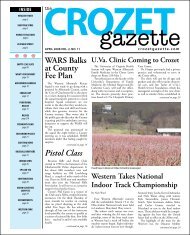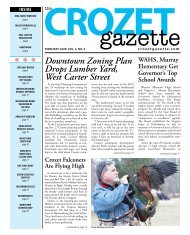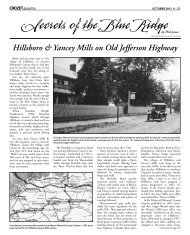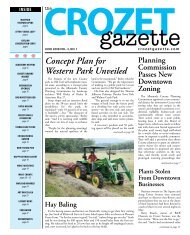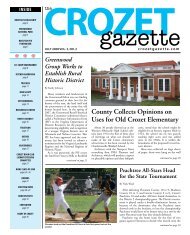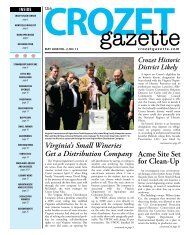Light Industrial Park Proposed for Yancey Mills - Crozet Gazette
Light Industrial Park Proposed for Yancey Mills - Crozet Gazette
Light Industrial Park Proposed for Yancey Mills - Crozet Gazette
Create successful ePaper yourself
Turn your PDF publications into a flip-book with our unique Google optimized e-Paper software.
<strong>Crozet</strong> gazette AUGUST 2008 s page 5<br />
by Phil James<br />
Farm auctions such as this one held near Mount Fair, too often denote the final passing of another honorable life spent<br />
working the land.<br />
The Disappearing Faces<br />
of Farming<br />
The gentle spirit of young Katie Maupin (1900–1998) was<br />
evident as she milked her family’s cow near Doylesville,<br />
Virginia. [Photo courtesy of Thelma Via Wyant.]<br />
Did you ever want to be a farmer?<br />
There’s nary a town nor village in<br />
Albemarle County that was not built to<br />
serve a surrounding community of farmers. The<br />
scores of discontinued post offices attest to <strong>for</strong>mer<br />
communities where farming families once<br />
gathered to check the mail, share news, and purchase<br />
or trade <strong>for</strong> provisions.<br />
It’s easy today to ignore the reality that the<br />
sprawling estates of old Albemarle, crowned with<br />
their palatial homes, were established as working<br />
farms. During the better years, the farms’ increases<br />
empowered the owners while supplying jobs, sustenance<br />
and housing to the laborers essential to<br />
farm operations.<br />
Colonial-era plantations that once supported a<br />
tobacco-based economy were sub-divided as the<br />
land yielded less of the prized product. Subsequent<br />
generations of land entrepreneurs positioned<br />
themselves <strong>for</strong> an ever-increasing population, paring<br />
down the grand old plantations into numerous<br />
smaller parcels. Land values were prudently<br />
based on the attributes of the soil, and houses<br />
were often relegated to a spot thought less convenient<br />
or profitable <strong>for</strong> tillage.<br />
One of the most obvious absences from the<br />
local real estate scene today is af<strong>for</strong>dable farm<br />
acreage. The Southern Planter magazine in 1893<br />
carried this print ad <strong>for</strong> Albemarle farm land:<br />
“Albemarle County. The great fruit, grain and<br />
stock section of Virginia. Climate healthful and<br />
fine. Scenery beautiful. Near the great markets,<br />
with good transportation facilities… Good soil at<br />
low prices. Sheep protected in this county by a<br />
good dog law.” Improved farmlands were<br />
offered at $9–$10/acre.<br />
An opportunity occasionally available<br />
to the farmer unable to buy land of his<br />
own was to sharecrop the lands of<br />
another. A 1918 Albemarle County<br />
sharecropper’s one-year lease agreement<br />
revealed the following conditions of one<br />
such enterprise: The farm owner received<br />
“one third (1/3rd) of all grain, and crops,<br />
and apples”; retained rights to harvest<br />
firewood and pasture his stock; and had<br />
no responsibility <strong>for</strong> damage his own<br />
stock might do to any crops on the farm.<br />
The leasing sharecropper furnished all<br />
seed and kept the farm in cultivation “as<br />
good husbandry requires”; furnished all<br />
barrels (owner to pay <strong>for</strong> 1/3rd of the<br />
barrels used) and spraying materials;<br />
pruned, tended, and sprayed the<br />
orchard in a proper manner; had the<br />
privilege of cutting and selling chestnut<br />
wood, paying 1/4th of those proceeds<br />
to the owner; had the privilege of using<br />
the horse called “Dan”, plus the use of<br />
a 2-horse wagon, harness and farming<br />
implements—and agreed to feed the horse.<br />
Mount Fair was one of the several estates established<br />
by members of the historic Brown family<br />
in the Brown’s Cove section of western Albemarle<br />
County in the 18th-century. James W. Early<br />
became the owner of this farm estate be<strong>for</strong>e the<br />
turn of the 20th-century. He employed many<br />
local hands in the operations of his farm, grain<br />
A significant shift in labor from agriculture to industry<br />
occurred during the 1950s. <strong>Crozet</strong>’s business community,<br />
however, was still being counted on to serve the farms and<br />
orchards of western Albemarle County.<br />
mill, and general store. One of those laborers<br />
was Laurie Sandridge (1890–1951), whose son,<br />
Homer, recalled some of his father’s experiences<br />
continued on page 6



